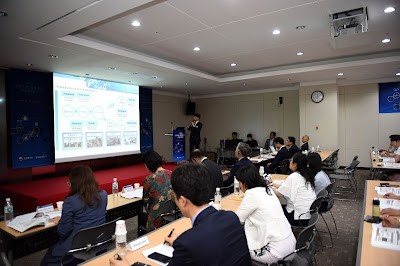International Conference Hosted to Globalize Korean Medicine
Top Asian pharmaceuticals from Japan,
China, Taiwan, Hong Kong, and Vietnam participate.
Representatives of the leading
pharmaceuticals from Japan, China, Taiwan, Hong Kong, and Vietnam convened to
hear the strategy to globalized Korean Medicine. The conference entitled The
2018 International Conference on Traditional Medicine was hosted by the
National Development Institute of Korean Medicine (NIKOM). Held this past July
at the Daegu EXPO Center, the conference provided a chance for the speakers
from pharmaceutical companies around the globe to present how they manage
traditional medicinal products and approach to the international market.
At the conference, NIKOM presented on
Modern Project of Korean Herbal Medicine. Based on figures from 2016, the
Korean medicinal market stands at 295.9 billion KRW (approx. $263 million USD)
with uhwang-cheongsimhwan comprising 21.4% of the market (55.2 billion KRW,
approx. $49 million USD). Below this is ssanghwatang at 6.5% (16.6 billion KRW,
approx. $14 million USD), galgeuntang at 4.8% (12.4 billion KRW, approx. $10
million USD), socheongryeongtang at 4.2% (10.8 billion KRW, approx. $8 million
USD), and eungyosan at 3.6% (9.3 billion KRW, approx. $7 million USD). Director
Lee hwa-dong of NIKOM explained, “There are so many different kinds of over the
counter (OTC) medications, but it was only just recently that national health
insurance upgraded their systems to include Korean medicines, and this is
spurring a lot of R&D to diversify herbal medicine formulations.
In 2017, sales for Chinese
pharmaceutical company Guangdong Yifang Pharmaceutical Co., Ltd. reached 4.1
billion RMB (approx. 666 billion KRW, approx. $593 million USD), and the
company presented on The Single TCM formula granules in today and future.
Manager Zhang Bin stated, “Since 1998, we have been exporting to over 30
countries around the world, including America, Canada, Austria, Malaysia,
Germany, France, and Switzerland and our sales have exceeded 45 million RMB
(approx. $6.5 billion USD).” He continued, “We hope that traditional medicine
will be successful in the global market, not only for China’s sake but for
human health.”
Hong Kong’s PuraPharm presented on
Global Outreach Plan, Use of BigData and Hightech. Vice Chairman Kam Biu Alvin
Tsoi explained, “Traditional Chinese medicine is being modernized and there is
a push to apply new technology and big data.” He continued, “PuraPharm has
attained 70% of market shares in Hong Kong and operates 64 Nongs Clinics to
manage everything from patient registration to diagnosis and medicinal
production to ensure a nearly 100% automated management system.”
Manager Wen-Ching Hsueh, Manager of Sun
Ten Pharmaceutical, presented on ‘Leading Innovation : Sun Ten Global Export
status & future strategy’. She mentioned that Sun Ten Pharmaceutical has a
wide range of export market including Canada, Japan, New Zealand, United States
and Macao, and that granules take about 60% of Sun Ten’s profit. Established in
1991, Sun Ten’s US branch sells Sun Ten’s products as health supplement food,
and they present various types of products blending other nutrients such as
Vitamin and Mineral.
Kracie Pharma of Japan presented on the
Japanese traditional medicine market and the manufacturing process. Vice
President of Kracie Pharma Korea Katsuyoshi Fujita said, “The Japanese
pharmaceutical market is worth 11.4 trillion JPY (approx. $102 billion USD)
according to figures from 2016, and of this is 10.6 trillion JPY (approx. $95
billion USD) in prescription drugs and 800 billion JPY (approx. $7 billion USD)
in over-the-counter drug sales.” He asserted, “Traditional medicines comprise
about 1.4% of the overall market but this figure will increase with the growing
elderly population.” Aside from this,
Quach Thi Ha Van of Thanh Phat Pharmaceutical JSC, Vietnam, presented on new
herbal medicine R&D trajectories and global market entry strategies.
K.M.D. Lee Eungse, president of host
institution, NIKOM, stated at the conference, “Networks between domestic institutions
and top international R&D leaders have been formed, and we are all working
to solidify these ties.” He also added,
“In the future we anticipate that the traditional Korean Medicine industry will
lead in international competitiveness with this global network.”
x










No comments